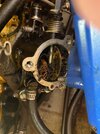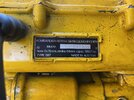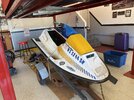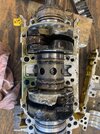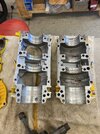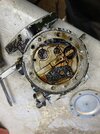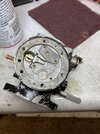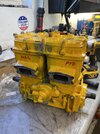PurplePackFan
New Member
Hello All,
I'm new here to the SeaDooForum and am in need of some guidance. My son acquired a 1990 SeaDoo GT with a yellow 587 Rotax engine that was in need of some serious "love". It was one of those deals where they had this at his work and since I work on small and automotive engines he asked if I was interested in a new "project".
Anyway, I said I would take a look at it and see if I could get it running. I've never worked on a Rotax before other than to rebuild carb on wife's '96 SeaDoo. This one was BAD. Acorns in the carb, milky oil in crankcase, the whole deal. Obviously it had sat a long time since "Bubba" had last tried to get it running. I ended up pulling engine and totally dissassembling it. Crank looked good, cylinders somewhat scarred, but not too bad, needed a good cleaning. I honed the cylinders and installed new rings, cleaned crankcase and installed all new seals and gaskets. Rotor valve was good along with brass gear. Installed seals using Loctite 518 on seals and crankcase flange. I was able to draw vacuum on rotor valve gear case after assembly. I got the engine assembled and running dry briefly but it took a while to get carb working to where it would run(That's another story in itself). Once I got the engine running on the carb I installed the pump and all of the coolant lines and felt comfortable putting water through the flush line. All water, oil and fuel lines were replaced with new hose. I started engine, open water hose, and ran it briefly. I shut it down after noticing moisture coming from spark plug threads.(Uh-Oh)
I removed plugs and cranked engine and had water spew from the spark plug holes.
My question is, where do I go from here? I did the flushing per service manual; water OFF, engine running, water ON. Water Off, shut down engine.
I did crank engine until no more water came out spark plug holes and sprayed some WD40 in cylinders. I did get it to fire again briely.
Do I need to check for cracks somewhere? Is there some way to determine where water is coming from? After a couple months of working on this project I really wanted it to run so I could move on to something else, now it looks like I will be starting over.
Any help or ideas?
Thanks in advance for your thoughts.
John
I'm new here to the SeaDooForum and am in need of some guidance. My son acquired a 1990 SeaDoo GT with a yellow 587 Rotax engine that was in need of some serious "love". It was one of those deals where they had this at his work and since I work on small and automotive engines he asked if I was interested in a new "project".
Anyway, I said I would take a look at it and see if I could get it running. I've never worked on a Rotax before other than to rebuild carb on wife's '96 SeaDoo. This one was BAD. Acorns in the carb, milky oil in crankcase, the whole deal. Obviously it had sat a long time since "Bubba" had last tried to get it running. I ended up pulling engine and totally dissassembling it. Crank looked good, cylinders somewhat scarred, but not too bad, needed a good cleaning. I honed the cylinders and installed new rings, cleaned crankcase and installed all new seals and gaskets. Rotor valve was good along with brass gear. Installed seals using Loctite 518 on seals and crankcase flange. I was able to draw vacuum on rotor valve gear case after assembly. I got the engine assembled and running dry briefly but it took a while to get carb working to where it would run(That's another story in itself). Once I got the engine running on the carb I installed the pump and all of the coolant lines and felt comfortable putting water through the flush line. All water, oil and fuel lines were replaced with new hose. I started engine, open water hose, and ran it briefly. I shut it down after noticing moisture coming from spark plug threads.(Uh-Oh)
I removed plugs and cranked engine and had water spew from the spark plug holes.
My question is, where do I go from here? I did the flushing per service manual; water OFF, engine running, water ON. Water Off, shut down engine.
I did crank engine until no more water came out spark plug holes and sprayed some WD40 in cylinders. I did get it to fire again briely.
Do I need to check for cracks somewhere? Is there some way to determine where water is coming from? After a couple months of working on this project I really wanted it to run so I could move on to something else, now it looks like I will be starting over.
Any help or ideas?
Thanks in advance for your thoughts.
John




